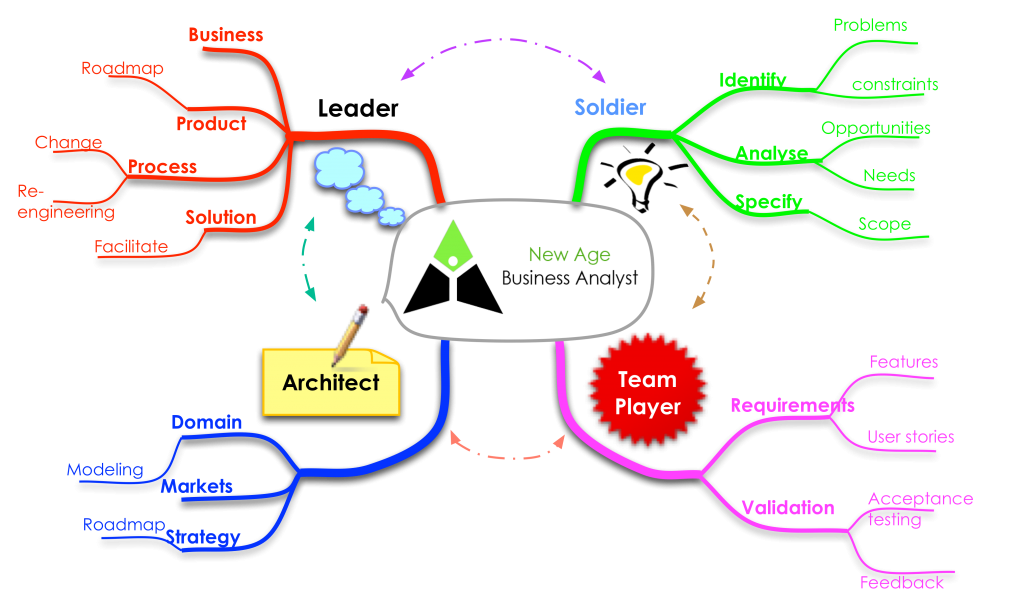Leader. Architect. Soldier. Team player – the many facets of Business Analyst
It is beyond doubt that the current times of digital, mobile and social age demand professionals who are versatile, agile, sociable and dynamic. Business Analysts and product specialists are no exception to this. Whether its due to the industry demands, peer pressure, market needs or pure evolutionary tactics, BAs today are far more leading-edge, competitive, assertive and visionary contributors to the products, processes and businesses, at large. From an also-ran team player role, new-age analysts have come a long way as the multi-disciplinary, multi-skilled and multi-dimensional professionals. In this post, I will touch upon the many facets of the new-age Business Analyst and how they are adapting to the continual changes happening in the spheres of business, technology, professional and personal lives.
Emergence of the new-age BA/PO
As we discussed in the previous posts, there have been several factors that led to the emergence and evolution of the Business Analyst. The BA today moved on from just a requirements owner and a document expert and is now addressing several facets around products, processes, business and technology. Their focus still remains pretty much around the problem space, compared to the facilitation role in the solution space. The analysts identify problems, dependencies, needs and opportunities. However, products, processes and business domains. The BAs today have been involved in scoping, release management, continuous engagement with customers and users, strategising, laying out roadmap, and working with multiple teams. In a nutshell, the Business Analyst of the modern age is much like a leader, architect, soldier, team player…all rolled into one.

Leader, architect, soldier, team player & more – the new-age BA
From being an analyst, the BA needs to transform into a leader, architect, soldier, team player and perhaps many more such roles, all rolled into one. Of course, they need not be all of these roles at the same time. The analyst today has to don one, few or all of these various roles based on the context, time, stage of implementation as befits the occasion. During the initial stages, the emphasis could be on being an architect, while during the scoping it could be that of a soldier. However, throughout the project, or initiative analysts have to keep their hat of leader and team player, no matter what stage the work is in. I touch upon the four primary facets of the new-age Business Analyst in the following paragraphs.
1. Sensible leader, not just an also-ran
You can’t talk enough about the all-imperative skill and art of analysts to work with people. They must have their hands firmly on the pulse of the different categories of people. These include the various stakeholders – direct and indirectly responsible for the product and process, from senior management all the way through to people working on the factory floor. As an able leader, the analysts must not only lead the way, but also set an example by following and working along with the team members. They should listen actively, take steps pro-actively and be able to put in their efforts with sustainable passion, drive and commitment to achieve this shared vision and common goals.
2. Architect and a builder, not just another player
New-age business analysts must be able to look beyond the near term goals and benefits. They must have a really good and long term vision to not only lead themselves but also the team members and the organisation, at large. They must think far and beyond, using their rich experience, in-depth and specialised domain expertise. The added advantage is that these help the analysts with a “peripheral vision” around the markets, business domains, products, processes and technologies. Besides, the new-age analyst adds great value by laying a robust roadmap that is flexible, scalable, high-performing.
3. A soldier, well-equipped and prepared
Like a soldier, who is well-equipped and well-prepared to face any kind of challenges, the new-age analyst must be prepared with all the right tools, methods and a positive attitude. The very nature and aptitude of business analysts help them to stay on the top of their game, be it at home or outside their turf. Their ability to adapt easily and quickly depending on the situation helps build on to the agility of the new-age analysts. Analysts’ skills of being sensitive, scrupulous and open-minded, help them usable insights from ideas and actionable intelligence from information. In addition to these, the BAs try to keep ahead by addressing all possible scenarios, potential challenges and constraints, internal and external dependencies and assumptions – stated and implicit.
4. Team player, not just a one-person show
Business analysts over the ages had been looked at more as specialised consultants who come in, do their work and get out. The contribution of analysts is considered from the prism of a “support” role who comes in early in the project, find problems, specify scope and requirements and exits the scenario. However, with the advent of agile practices such as Scrum, user stories, XP, BDD and TDD being put in place, organisations are increasingly looking for analysts to be well-integrated into the development teams. The analysts today are very much an integral part of the teams and by being participative, they contribute to the collective value delivered by the team. So, new-age analysts are equally adept at being followers and team members themselves as much as they excel at leading the teams.
I hope this post helped you understand the many dimensions, skills and demands of the new-age business analyst. We will cover more specific details on the tools, and methods for the business analyst/product owner in the upcoming posts, until then, ciao!

Responses